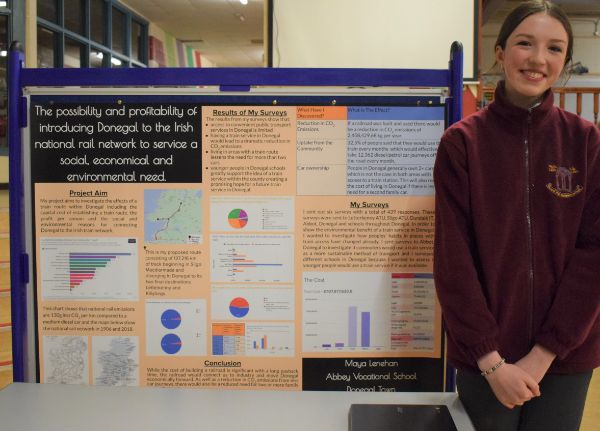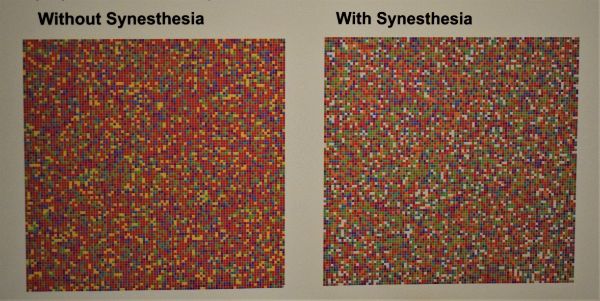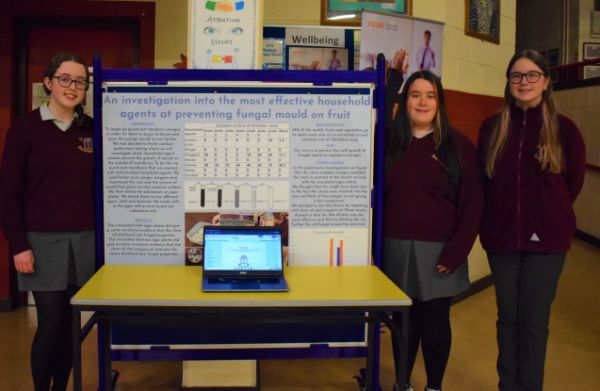Ciara Cannon has finished second in her category in the BTYSTE last year and has taken her research even further for this year's entry
The Abbey Vocational School in Donegal Town has six projects in the BT Young Scientist and Technology Exhibition running in the RDS this week.
Before they set off for Dublin, journalist Siobhán McNamara caught up with the students to find out more about their projects.
Participating in the exhibition for the second time, Michael Masterson has designed a smart bag that alleviates the weight issues that students are experiencing with heavy school bags.

After trying several prototypes, Michael came up with a design that is comfortable to wear and will greatly ease the burden on students. The pneumatic system uses purpose designed air bladders, tubes and connections that allow the entire system to be easily adjusted with a single hand pump.
Like so many great ideas, one wonders why it is not already widely available.
Michael is optimistic that his product not only has significant health benefits but could also be made widely available.
“I hope to see it mass produced,” he said.
Maya Lenehan’s project will be sure to strike a chord with many people in Donegal.
She has carried out detailed research into the possibility and profitability of introducing Donegal to the Irish national rail network to service a social, economical and environmental need.

From costing to market research, to the positive environmental impact, Maya has been thorough in her investigations.
Among her findings were: that one in three people in a large Donegal Town factory said they would use the train to commute; that in test comparison areas of Sligo and Dundalk which have access to rail, most households had either one car or did not own a car at all, compared to most households in Donegal requiring two cars.
“In 1906, we had the longest single track railway in Europe,” said Maya. “It would bring so much to industry and tourism in Donegal to bring it back, and it would be very important for the environment.”
Maya’s research will be a great addition to any campaigns to bring rail travel back to Donegal.
Jack Hannigan’s project was inspired by a previous qualifying project. He saw Eadaoin Murphy and Joseph Woods’ 2020 project on the antimicrobial properties of locally available seaweeds on the wall in school.
“I thought it would be really interesting to find out if there was any seasonal variation in the level of antimicrobial activity,” he said.

“I tested a number of seaweeds every month and found that March, April and May were significant for most, and just March and April for one of them.
“It is notable that this coincides with the growing season of these seaweeds.”
With increasing antibiotic resistance and the current medicine shortage, this is very timely research.
Ciara Cannon is building on her success of last year when she finished second in her category for her investigation into antimicrobial nanoparticles.
For her project this year, Ciara is using silica nanoparticles to create self sustaining antimicrobial surface coatings.

She believes this research could help make medical implants significantly safer, and that it also has a role in preventing the spread of infection and reducing cross contamination in hospitals.
Her findings were not only useful but also raised some interesting questions, leading her into even deeper research.
“I would really like to study this even further, given the opportunity,” said Ciara.
Samaire Fern’s study of synesthesia is based around the question she poses, ‘What colour is Pi?”

Synesthesia is broadly defined as the blending of senses in the brain, for example, some synesthetes ‘see’ music in colour.
Samaire uses Pi, which to most people is simply a string of numbers, to help create a visual representation of how synesthetes experience numbers. To make a comparison, she also invited people who did not experience synesthesia to take part, with each one choosing colours to represent the numbers.
Her findings showed that those without synesthesia choose brighter colours to associate with the numbers, with very few choosing white.
Those who experience synesthesia indicated the colours which they naturally associate with the various numbers. The colour association that occurred naturally consisted of fewer bright colours, with notably more white.

Many people have a degree of colour association that is often related to how they learned the alphabet, the days of the week, etc.
“The difference for people with synesthesia is that they can’t switch it off, it is there all the time,” said Samaire. “It is how they experience the world.”
Jane Faulkner, Amy McGroary and Robyn Given are in the exhibition stage of the competition for a remarkable fourth time.
Inspired by videos on TikTok, they set out to establish if common household items could prevent fungal mould on fruit.
They used a number of store cupboard staples in their tests, finding that cloves and oregano were particularly effective.
The team believe their research could reduce food waste and the use of harsh chemicals.

The school’s BTYSTE coordinator is Science teacher, Ms Donna Furey. She is very proud of all the students who have been selected for the exhibition stage of the competition.
“We have had 20 projects in the exhibition in the last four years,” said Ms Furey.
This is more than any other school in the county, and as well as reaching the final stages, students have brought home a few prizes and commendations.
“Ciara [Cannon] was second last year in her category, a fantastic achievement,” said Ms Furey. “We have a few highly commended projects over the last four years too.”
Ms Furey’s passion for her subject and for nurturing the next generation of scientists is very apparent. And she believes that a good grounding in science could help young people find work closer to home.
“There are a lot of scientific industries in Donegal,” she said.
“We have a responsibility as science teachers to produce potential employees for those industries.”
Seeing the skill, knowledge, creative thinking and passion amongst this year’s BTYSTE participants, the AVS science department has every reason to be proud. The future of science and innovation in Donegal looks very bright indeed.
Subscribe or register today to discover more from DonegalLive.ie
Buy the e-paper of the Donegal Democrat, Donegal People's Press, Donegal Post and Inish Times here for instant access to Donegal's premier news titles.
Keep up with the latest news from Donegal with our daily newsletter featuring the most important stories of the day delivered to your inbox every evening at 5pm.